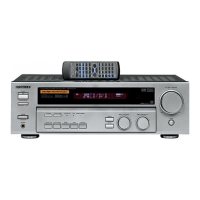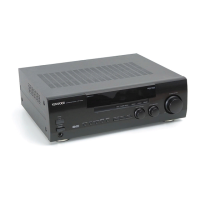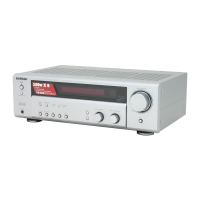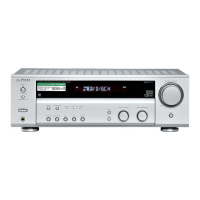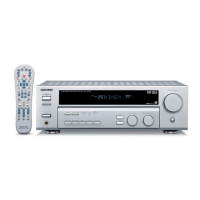
Do you have a question about the Kenwood KRF-V4550D and is the answer not in the manual?
| rated power output stereo operation | 80 W + 80 W |
|---|---|
| effective power output surround operation front | 80 W + 80 W |
| effective power output surround operation center | 80 W |
| effective power output surround operation surround | 80 W + 80 W |
| total harmonic distortion | 0.05% (1 kHz, 40W, 4Ω) |
| frequency response CD | 40 Hz ~ 60 kHz, +0 dB, –3.0 dB |
| signal to noise ratio phono (MM) | 74 dB |
| signal to noise ratio CD | 90 dB |
| input sensitivity / impedance phono (MM) | 2.5 mV / 27 kΩ |
|---|---|
| input sensitivity / impedance CD | 200 mV / 47 kΩ |
| input sensitivity / impedance monitor in (VIDEO2/MONITOR) | 200 mV / 47 kΩ |
| input sensitivity / impedance DVD/6ch INPUT | 200 mV / 47 kΩ |
| output level / impedance TAPE REC | 200 mV / 1 kΩ |
| output level / impedance MONITOR OUT (VIDEO2/MONITOR) | 200 mV / 1 kΩ |
| output level / impedance PRE OUT (SUBWOOFER) | 2 V / 2.2 kΩ |
| bass | ±10 dB (at 100 Hz) |
|---|---|
| treble | ±10 dB (at 10 kHz) |
| sampling frequency | 32 kHz, 44.1 kHz, 48 kHz, 96kHz |
|---|---|
| input level / impedance / wave length optical | (-15 dBm ~ -21 dBm), 660 nm ±30nm |
| input level / impedance coaxial | 0.5 Vp-p / 75 Ω |
| video inputs / outputs composite | 1 Vp-p / 75 Ω |
|---|
| tuning frequency range | 87.5 MHz ~ 108 MHz |
|---|---|
| usable sensitivity mono | 1.3 µV/13.2 dBf (40 kHz dev. S/N 26 dB) |
| usable sensitivity stereo | 45 µV/42.1 dBf (46 kHz dev. S/N 46 dB) |
| total harmonic distortion mono | 0.2% (71.2 dBf input) |
| total harmonic distortion stereo | 0.8% (71.2 dBf input) |
| signal to noise ratio mono | 65 dB (40 kHz dev.71.2 dBf input) |
| signal to noise ratio stereo | 60 dB (46 kHz dev. 71.2 dBf input) |
| stereo separation | 36 dB |
| selectivity | 64 dB |
| frequency response | 30 Hz ~ 15kHz, +0.5 dB, –3.0 dB |
| tuning frequency range | 531 kHz ~ 1, 602 kHz |
|---|---|
| usable sensitivity | 16 µV / (600 µV/m) |
| signal to noise ratio | 50 dB |
| power consumption | 220 W |
|---|---|
| dimensions width | 440 mm |
| dimensions height | 143 mm |
| dimensions depth | 400 mm |
| weight | 8.9 kg |
Unpacking the unit, checking all accessories, and retaining packing materials.
Critical safety advice including fire/shock hazards and symbol explanations.
Procedure for handling microcomputer malfunctions and erroneous displays.
Instructions for cleaning the unit's exterior with a soft, dry cloth.
Caution against using contact cleaners to prevent malfunction or damage.
Outlines the manual's structure: Preparations, Operations, and Additional Information.
Highlights special features like surround sound modes, Dolby technologies, and RDS tuner.
Lists settings that are lost if the power cord is disconnected for an extended period.
Details power, input selection, and setup controls on the receiver's front panel.
Explains controls for sound, listening modes, muting, and speaker selection.
Describes the function of various indicator lights on the display panel.
Overview of the remote's buttons and their primary functions.
Details on selecting sources, modes, and using tuning/playback controls.
How to use VIDEO 2/MONITOR jacks for video playback or monitor functions.
Guides on selecting digital, analog, or auto sound input modes for various sources.
Illustrates connecting audio sources like CD players and record players via RCA cables.
Details connecting components via SYSTEM CONTROL jacks for integrated operation.
Diagram showing how to connect video decks, DVD/LD players, and monitor TVs.
Explains connecting a DVD player for 6-channel surround sound input.
Important notes on proper ventilation and heat dissipation for the unit.
Details connecting digital sources like CD players and LD players via optical and coaxial cables.
Instructions for connecting an LD player with DIGITAL RF OUT via a demodulator.
Instructions for connecting the AM loop antenna and its terminal connections.
Guides on connecting FM indoor and outdoor antennas to the receiver.
How to connect KENWOOD components for integrated system control operations.
Details on Remote Control, Automatic Operation, and Synchronized Recording features.
Step-by-step instructions for connecting front, center, and surround speakers correctly.
Explains matching speaker impedance to the receiver's specifications to prevent damage.
Guidance on positioning speakers for ideal surround sound effects.
Instructions for loading batteries, operating the remote, and understanding its infrared system.
Steps to configure subwoofer and front speaker settings and their options.
Guides on setting center and surround speakers and adjusting their volume levels.
How to measure and input distances from the listening position to each speaker.
Adjusting input levels for analog sources if the signal is too high.
Steps to change the source name for MD/TAPE input from TAPE to MD.
How to select a source component and adjust playback volume.
Adjusting bass, treble, applying bass boost, and volume for sound quality.
How to mute sound, use SOURCE DIRECT, and set up headphone listening.
Guides on recording music from analog sources to tape or MD.
Explains using the MONITOR function for tape-to-tape recording.
Steps for selecting video sources and recording them to a video deck.
Explains A-REC and M-REC modes for recording digital audio sources.
Basic steps for tuning AM and FM radio stations.
Details on RDS features like PTY search, station name display, auto memory, and radio text.
How to cycle through RDS display modes: PS, RT, and frequency.
Instructions for automatically storing up to 40 RDS stations into preset memory.
Steps to manually store AM, FM, and RDS stations into preset memory slots.
How to recall preset stations sequentially using P.CALL keys.
How to activate and perform a search for stations broadcasting specific program types.
A table listing program types and their display codes for PTY search.
Explains the benefits and characteristics of Dolby Digital surround sound.
Describes Pro Logic for theater-like sound and 3 Stereo for systems without surround speakers.
How to achieve multi-channel surround sound from DVD players.
How to select listening modes like Pro Logic, 3 Stereo, or Dolby Digital.
How the receiver automatically selects modes based on input signal type.
Steps to connect a DVD player for 6-channel surround sound.
How to adjust bass, treble, speaker levels, and apply midnight mode.
How to adjust the brightness of the receiver's display.
Information on 96kHz LPCM playback compatibility and mode selection.
Instructions for operating KENWOOD DVD players using the receiver's remote control.
How to set up the receiver remote to control different groups of KENWOOD DVD players.
Operation charts for controlling cassette decks and CD players with the remote.
Operation charts for controlling MD recorders with the remote control.
Steps to reset the microcomputer to resolve malfunctions and erroneous displays.
Common amplifier symptoms, causes, and remedies for issues like no sound or interference.
Common tuner symptoms, causes, and remedies for issues like no reception or interference.
Detailed specifications for audio power output, distortion, frequency response, and tuner performance.
Specs for video I/O, digital audio capabilities, power, dimensions, and weight.
